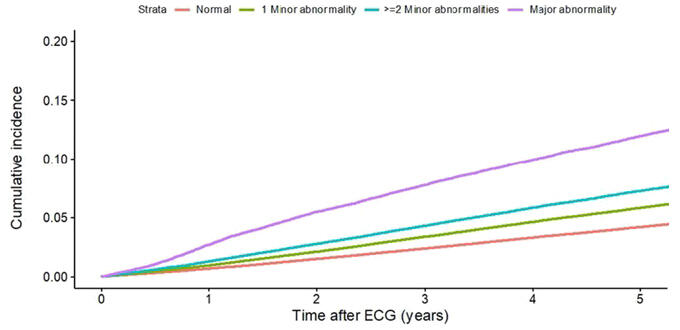In Japan, people undergo electrocardiography (12-lead electrocardiography) during health checkups; however, routine electrocardiogram screening is not recommended in Europe and the United States, and its significance as a test is being questioned. A research group led by Associate Professor Kosuke Inoue, Professor Taku Iwami, and Doctoral Student Yuichiro Mori of the Graduate School of Medicine at Kyoto University, and Research Fellow Ryuichiro Yagi and Instructor Shinichi Goto of Harvard Medical School in the United States analyzed the data (for about 3 million people) on lifestyle-related disease prevention checkups and insurance claims from the Japan Health Insurance Association (JHIA). They found that the risk of developing cardiovascular disease (CVD) in the future was increased in people who were identified to have electrocardiogram abnormalities in health checkups. The results were published in JAMA Internal Medicine.

Provided by Kyoto University
Inoue said, "It is significant that we have bridged the gap between what we have taken for granted and the evidence. In the first place, there were no data on electrocardiograms and follow-up in healthy people worldwide. A study commissioned by the JHIA started 3 years ago, and it is very groundbreaking that we are now able to analyze these data from that study."
Analysis of data collected for 3.69 million people over 5 years (2016−2022) revealed that the risk levels of developing CVD in those with one mild electrocardiogram abnormality, those with two or more mild abnormalities and those with major abnormalities were 1.19 times, 1.37 times and about twice as high as the risk in those with normal electrocardiograms, respectively. Furthermore, the research group found that the risk of having major electrocardiogram abnormalities in subsequent years in those who had a mild electrocardiogram abnormality and two or more mild electrocardiogram abnormalities in 2016 was 2.5 times and approximately 3.6 times higher than the risk in those who had normal electrocardiograms in 2016, respectively.
While previous studies have indicated associations between electrocardiogram findings and the incidence of CVD, the role of electrocardiogram screening in the general population has never been evaluated comprehensively. The results of this study suggest the potential usefulness of electrocardiography in health checkups, which is common in Japan, for evaluating the risk of CVD. As the burden of CVD is increasing worldwide, a population-based approach using simple and inexpensive electrocardiogram screening may be reacknowledged.
Yagi said, "We were able to clarify the significance of electrocardiogram screening because unbiased data from the general population over time were available. As a next step, I would like to analyze health checkup data using artificial intelligence to identify risks in individuals."
Mori said, "We believe that interventions after electrocardiogram abnormalities represent a key to prevention. Currently, there are no established approaches in the system for those with electrocardiogram abnormalities. I think that discussion about what level of abnormality should be the target of medical care and what kind of medical care should be provided should be started."
Journal Information
Publication: JAMA Internal Medicine
Title: Routine Electrocardiogram Screening and Cardiovascular Disease Events in Adults
DOI: 10.1001/jamainternmed.2024.2270
This article has been translated by JST with permission from The Science News Ltd. (https://sci-news.co.jp/). Unauthorized reproduction of the article and photographs is prohibited.




